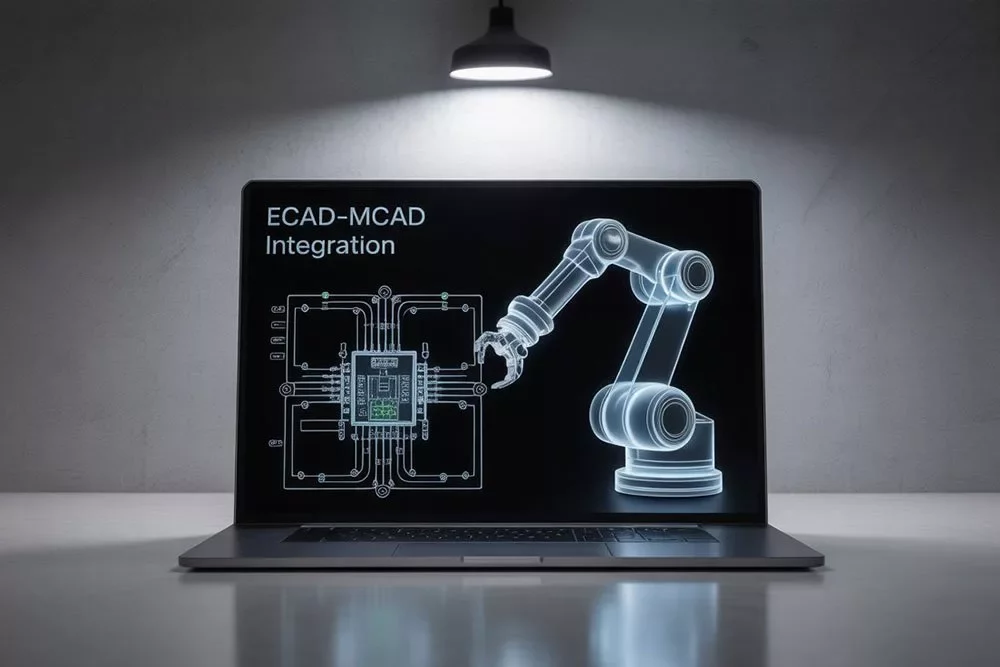
Modern industry is faster, more complex and more global than ever before. Products have more variants, development cycles are getting shorter, supply chains are internationally networked - and yet customers still expect the highest quality. If you want to keep up, you need digital consistency. Without clean data flows from engineering to service, errors, delays and unnecessary costs arise.
This is exactly where ECAD/MCAD integration comes in. It combines mechanical design (MCAD) with electrical engineering (ECAD) - two worlds that have long existed side by side. The result: mechatronic parts lists, consistent data and the basis for a resilient digital twin.
With ECAD Collaboration and Siemens Teamcenter, companies have powerful tools at their disposal to build this bridge.
👉 Download white paper on ECAD/MCAD integration
In many companies, mechanical and electrical engineering still work in separate worlds. MCAD engineers define assemblies, while ECAD designers model circuit diagrams. Both sides create their own parts lists, maintain articles twice and laboriously coordinate via email or Excel.
The consequences:
If data is stored in separate systems, there is no continuous information chain. This makes it impossible to create a digital twin that provides reliable information throughout the entire life cycle.
Without integration, there is no single source of truth. Instead, departments work with different revision levels. This increases the coordination effort, reduces data quality and leads to delays. In addition, there is often no clear single point of truth - the unambiguous reference within a project that applies to everyone.
The combination of ECAD Collaboration and Siemens Teamcenter puts an end to these problems. EPLAN® remains the leading authoring system for electrical engineering, while Teamcenter functions as the central PLM system.
Central advantages
👉 Find out more now: Download whitepaper
With ECAD Collaboration, EPLAN projects are saved directly in Siemens Teamcenter. Project metadata (name, status, reason for change) is automatically transferred. Thanks to revision-proof storage, all versions are traceable.
The biggest lever: ECAD and MCAD data flow together to form mechatronic parts lists. These contain mechanical components, electrical devices and logical links. Purchasing has a consolidated basis, production has a reliable working basis and service has a complete image.
Items from EPLAN® are synchronized directly with Siemens Teamcenter. Uniform IDs ensure that the same information is used everywhere. Changes automatically take effect in all projects - a clear advantage in change management.
When saving, ECAD Collaboration automatically creates PDFs or DXFs. These are stored in the PLM system and are also available without an ECAD license. This increases transparency and reduces queries.
With Siemens Teamcenter, data can be searched across projects. Components can be reused and dependencies recognized. This saves time and improves quality.
The quality of mechatronic parts lists is crucial. Purchasing, production and service can only work efficiently with consolidated and audit-proof parts lists.
Without consistent parts lists, the digital twin remains an empty shell. Only the combination of ECAD and MCAD data in the PLM system provides real added value.
👉 Download whitepaper now free of charge
A medium-sized mechanical engineering company was struggling with unclear parts lists and media disruptions. After the introduction of ECAD Collaboration and Siemens Teamcenter, the results improved significantly:
Legal requirements, sustainability and verification obligations present companies with new challenges.
ECAD/MCAD integration is no longer a nice-to-have. It is the basis for digital consistency, a functioning digital twin, clean mechatronic parts lists and a reliable PLM system.
👉 Companies that use ECAD Collaboration and Siemens Teamcenter are creating the basis for efficiency, quality and future viability today.
DataSolid continues to evolve: with a new look, new telephone number and a new extended partner solutions.What remains the same? Our claim to be there for you - personal, technical, reliable.